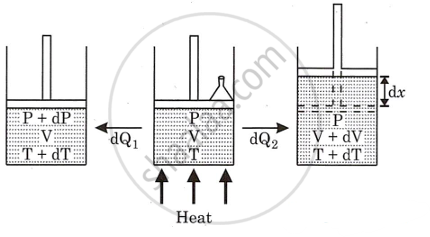Advertisements
Advertisements
प्रश्न
Prove the Mayer's relation `C_p - C _v = R/J`
उत्तर
Consider one mole of an ideal gas that is enclosed in a cylinder by a light, frictionless, airtight piston.
Let P, V, and T be the pressure volume and temperature of the gas, respectively. If the gas is heated so that its temperature rises by dT, but volume remains constant.
Let dQ1 → be the amount of heat supplied to the gas,
dE → be the increase in internal energy. Since, volume of gas is constant, no work is done in moving the piston.
dQ1 = dE + dW
∴ dQ1 = dE = CVdT ...(i)
(As dW = 0)

If the gas is heated to the same temperature at constant pressure.
Let dV → be the increase in volume.
Therefore work is done and it is given by
dW = PdV
Let dQ2 → be the heat supplied to the gas
∴ dQ2 = dE + dW
∴ CpdT = dE + dW ...(ii)
Putting dE = CvdT and dW = PdV
∴ Equation (ii) becomes
CPdT = CvdT + PdV
(Cp − Cv)dT = PdV ...(iii)
For one mole of gas
PV = RT
∴ pdV = RdT
∴ (Cp − Cv)dT = RdT
Cp − Cv = R ...(iv)
This is known as Mayer's relation.
Generally, heat supplied is measured in calories, and work done is measured in joules. Therefore, equation (iv) is modified as follows:.
`C_p - C _v = R/J`
APPEARS IN
संबंधित प्रश्न
In an experiment on the specific heat of a metal, a 0.20 kg block of the metal at 150 °C is dropped in a copper calorimeter (of water equivalent 0.025 kg) containing 150 cm3 of water at 27 °C. The final temperature is 40 °C. Compute the specific heat of the metal. If heat losses to the surroundings are not negligible, is your answer greater or smaller than the actual value for the specific heat of the metal?
The temperature of 170 g of water at 50°C is lowered to 5°C by adding a certain amount of ice to it. Find the mass of ice added.
Given: Specific heat capacity of water = 4200 J kg-1 °C-1 and specific latent heat of ice = 336000 J kg-1.
Why do the farmers fill their fields with water on a cold winter night?
Explain the term boiling ?
How will rise in sea level affect population in coastal countries?
How will climate changes affect the various animal species?
What impact will climate changes have on the crops of food?
How will global warming disturb the ecological balance?
Write two advantages of high specific heat capacity of water.
Does the specific heat capacity of a substance depend upon its mass and rise in temperature only?
Explain, why is water sprayed on roads in evening in hot summer?
Explain, Why is it advisabile to pour cold water over burns, caused on human body, by hot solids?
An equal quantity of heat is supplied to two substances A and B. The substance A shows a greater rise in temperature. What can you say about the heat capacity of A as compared to that of B?
Ice-cream at 0°C feels colder than water at 0°C. Give reason for this observation.
Why are athletes advised to put on extra clothes after competing on event?
A piece of iron of mass 2.0 kg has a thermal capacity of 966 J/°C. What is its specific heat capacity in S.I. units?
Numerical Problem.
What could be the final temperature of a mixture of 100 g of water at 90 °C and 600g of water at 20°C.
Numerical Problem.
How much heat energy is required to change 2 kg of ice at 0°C into water at 20°C? (Specific latent heat of fusion of water = 3,34,000 J/kg, Specific heat capacity of water = 4200 JKg–1K–1).
Express the change in internal energy in terms of molar specific heat capacity.
If 'f' is the number of degrees of freedom of a molecule of a gas and ratio of molar specific heats of a gas, ϒ = 1 + `2/"f"` where ϒ = Cp/Cv. The ratio of 'ϒ' for monoatomic gas to 'ϒ' for (rigid) f diatomic gas is ______.
The molar specific heat of an ideal gas at constant pressure and constant volume is 'Cp' and 'Cv' respectively. If 'R' is the universal gas constant and the ratio 'Cp' to 'Cv' is 'γ' then CV = ______.
The ratio of the specific heats `c_"p"/c_"v"=gamma` in terms of degrees of freedom 'n' is given by ______.
Two metals A and B have specific heat capacities in the ratio 2:3. If they are supplied same amount of heat then
If specific heat capacity of metal A is 0.26 Jg-1 0C-1 then calculate the specific heat capacity of metal B.
What is the amount of heat required to raise the temperature of 5 kg of iron from 30°C to 130°C? Specific heat capacity of iron = 483 Jkg-1C-1.
Match the columns:
| Column ‘A’ | Column ‘B’ |
| The SI unit of specific heat capacity | (a) Jkg−1°C−1 |
| (b) kg/m3 | |
| (c) calorie |
Find the odd one out:
A block of ice of mass 120 g at temperature 0°C is put in 300 gm of water at 25°C. The xg of ice melts as the temperature of the water reaches 0°C. The value of x is ______.
[Use: Specific heat capacity of water = 4200 Jkg-1K-1, Latent heat of ice = 3.5 × 105 Jkg-1]
Specific heat capacity of a substance X is 1900 Jkg-1°C-1 means ______.
